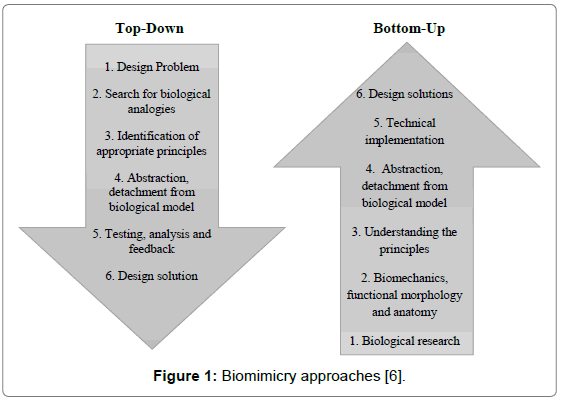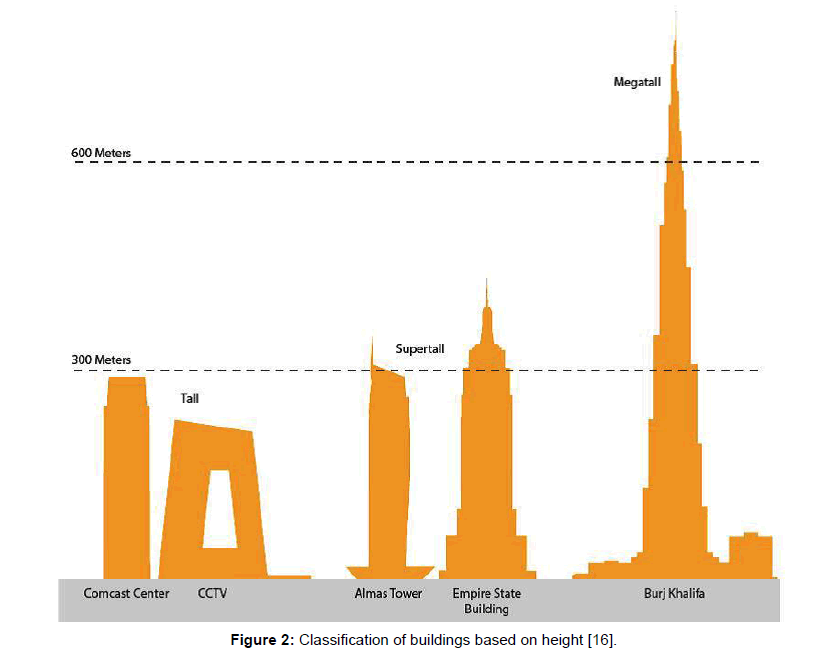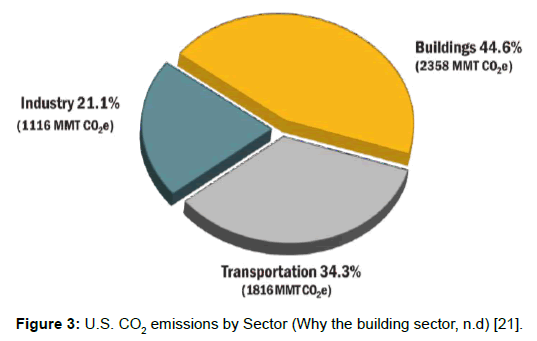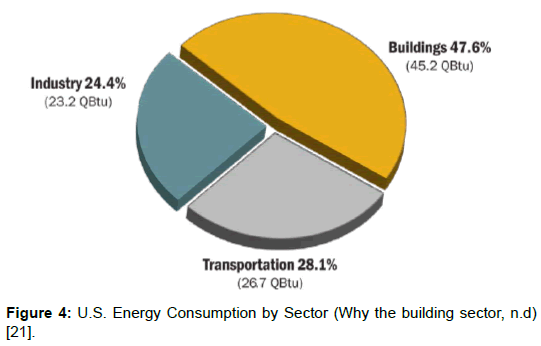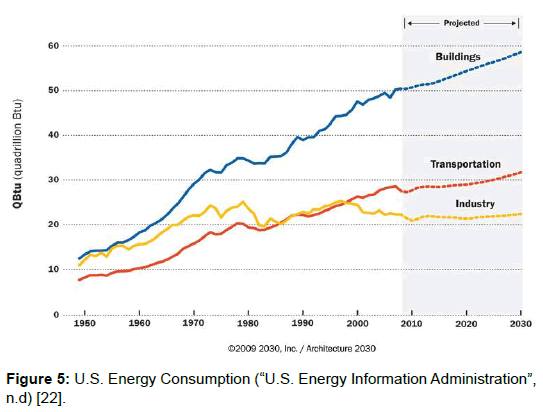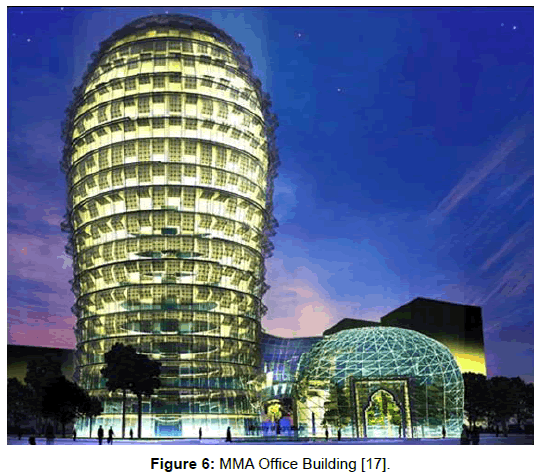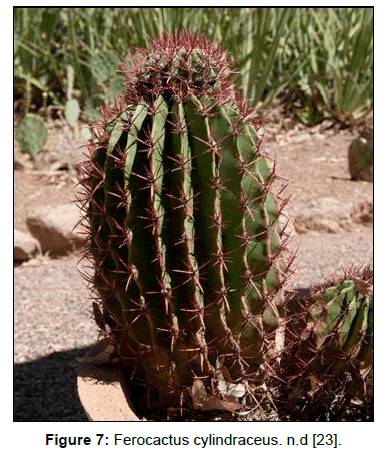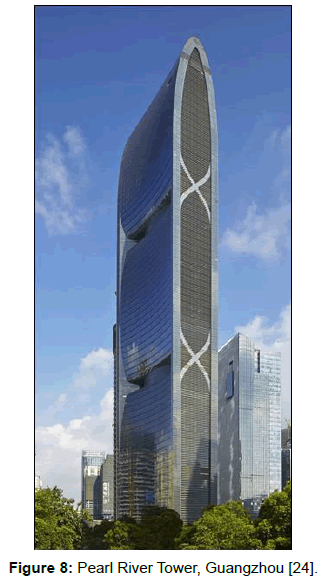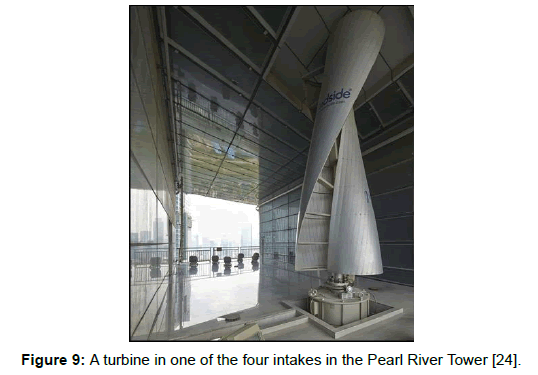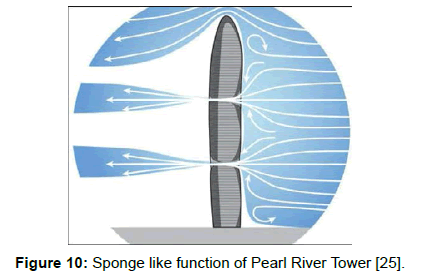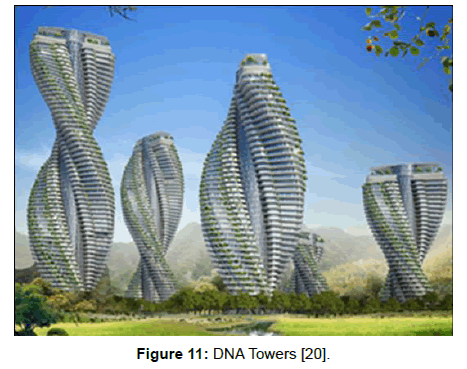Biomimicry an Approach toward Sustainability of High-Rise Buildings
Received: 27-May-2017 / Accepted Date: 23-Jun-2017 / Published Date: 28-Jun-2017 DOI: 10.4172/2168-9717.1000203
Abstract
Buildings are the main destination for the nation's power supplies. High-rise buildings due to their large scale require much more materials for their construction compared to low-rises. In addition, they use more energy and emit greenhouse gasses, as a result, they have major environmental impacts. Therefore, high rises seem to be nonsustainable. With increasing popularity of high rises, achieving a high level of sustainability has become the leading subject of the architectural designs. Hence, the efforts for combining technology and biology are largely these days. Biomimicry is a concept that talks about the ideas inspired by nature and it has been offered as an optimal solution for the conflicts between nature and human activities. As it said, nature is an excellent and the final response to the problem of sustainability. Therefore, architects have employed biomimicry approach in their designs to minimize buildings negative impacts on the environment and reach overall architectural sustainability. This paper studies different approaches and levels of biomimicry and discusses their application in high-rise buildings. It is shown that employing different principles of biomimicry may result in diverse outcomes in terms of tall buildings sustainability
Keywords: Biomimicry; High-rise building; Nature; Sustainability; Tall building
77300Introduction
With the population growth and the scarcity of land in the inner cities, the average building height is increasing. Separating living or working places from the ground and placing them in height, solves the scarcity of land in the big cities; but it also separates people from nature and ground. On the other hand, high-rise buildings have destructive environmental impacts such as carbon dioxide emission and high-energy consumption. One innovative approach to achieve harmonious coexistence between human society and nature is biomimicry. Architects have considered nature as a great source of inspiration for centuries. Nature provides creative solutions for human problems. Biomimicry claims that nature is the most effective source of innovation for designers. Biomimicry is an inspiration for intelligent and innovative engineering for minimizing or eliminating the negative impact of the construction industry on the environment and reaching overall sustainability of the buildings. The growing international research on biomimicry in the building sector reveals various obstacles in the path of this method. One of them is the lack of a clear approach that architects can employ [1]. In this regard, this paper studies different approaches and levels of biomimicry that have evolved during recent years, exemplifies, and discusses three tall buildings that biomimicry principles are applied in their design. The case studies show that employing different levels of biomimicry might result in various effects in high-rises sustainability.
Biomimicry Definition
The term Biomimicry derives from two words, Bio means life and mimicry means imitating. Some scientists preferred to use the term Biomimicry and the others preferred to use the term Bionic (Pawlyn, 2011). The main aim of biomimicry is the creation of great designs by imitating various living organisms that they have evolved during the 3.8 billion years [2]. Benyus J defined Biomimicry as "a new discipline that studies nature’s best ideas and then imitates the designs and processes to solve human problems [3]"
Background of Biomimicry
Biomimicry invented and published by Prof. Benyus Janine in her book (Innovation Inspired by Nature) in 1997. She proposed biomimicry as a new science that studies the models of nature and imitates their designs for solving human problems. Biomimicry is nothing new; people have been inspired by nature for a long time. However, Leonardo da Vinci conducted the first scientific study in this field in 1482. He tried to invent flying machines by studying the mechanism of the birds flying. Although he was not successful with his flying machine but his idea was an inspiration for the Wright Brothers to invent the first airplane in 1948 that is the best-known biomimicry invention.
Biomimicry in Architecture
Nature is everywhere and affects everything; it initiates life in the creatures. One of the important solutions for design, whether in architecture or other arts and sciences has been modeling and imitating nature [4]. Solving several problems in architecture is only through the innovative solutions; the models inspired by nature can cause creativity and innovation in the architect's mind. The transition from nature to architecture is a logical process because the natural models have provided the best type of adaptation under a variety of conditions over the years.
Biomimicry Approaches
Approaches to biomimicry as a design process fall into two categories [5]
Design looking to biology
In this approach, designers identify a human need or design problem and they seek the solutions in nature and organisms [5]. This approach is used when designers are confident about the aims of their designs. This approach is also called ‘‘Top-down Approach” [6] and ‘‘Problem-Driven Biologically Inspired Design” [7].
Biology influencing design
When designers have the knowledge of biological research and it influences human designs rather than first determining human design problems. This approach is also called ‘‘Bottom-Up Approach” [6] and ‘‘Solution-Driven Biologically Inspired Design” [7]. Biomimicry approaches illustrates these two approaches (Figure 1).
Biomimicry Levels
In addition to these two approaches, three levels of biomimicry that can be applied in design problems are form, process, and ecosystem [5]. Through each level, there are five possible dimensions to imitate (Table 1).
| Level of Biomimicry | Example - A building that mimics termites | |
|---|---|---|
| Organism level (Mimicry of a specific organism) | Form | The building looks like a termite. |
| Material | The building is made from the same material as a termite; a material that mimics termite exoskeleton / skin for example. | |
| Construction | The building is made in the same way as a termite; it goes through various growth cycles for example. | |
| Process | The building works in the same way as an individual termite; it produces hydrogen efficiently through meta-genomics for example. | |
| Function | The building functions like a termite in a larger context; it recycles cellulose waste and creates soil for example. | |
| Behavior level | Form | The building looks like it was made by a termite; a replica of a termite mound for example. |
| (Mimicry of how an organism behaves or relates to its larger context) | Material | The building is made from the same materials that a termite builds with; using digested fine soil as the primary material for example. |
| Construction | The building is made in the same way that a termite would build in; piling earth in certain places at certain times for example. | |
| Process | The building works in the same way as a termite mound would; by careful orientation, shape, materials selection, and natural ventilation for example, or it mimics how termites work together. | |
| Function | The building functions in the same way that it would if made by termites; internal conditions are regulated to be optimal and thermally stable for example. It may also function in the same way that a termite mound does in a larger context. | |
| Ecosystem level (Mimicry of an ecosystem) | Form | The building looks like an ecosystem (a termite would live in). |
| Material | The building is made from the same kind of materials that (a termite) ecosystem is made of; it uses naturally occurring common compounds, and water as the primary chemical medium for example. | |
| Construction | The building is assembled in the same way as a (termite) ecosystem; principles of succession and increasing complexity over time are used for example. | |
| Process | The building works in the same way as a (termite) ecosystem; it captures and converts energy from the sun, and stores water for example. | |
| Function | The building is able to function in the same way that a (termite) ecosystem would and forms part of a complex system by utilizing the relationships between processes; it is able to participate in the hydrological, carbon, nitrogen cycles etc. in a similar way to an ecosystem for example. | |
Table 1: A Framework for the Application of Biomimicry [5].
Although these levels may have some overlap, they are necessary for completing biomimicry approaches.
Sustainable Architecture
Sustainable buildings are “causing as little environmental interference as possible, such as, the use of friendly environmental materials that do not constitute a health hazard, low energy requirements, renewable energy use, high-quality and longevity as a guideline for construction, and last but not least, an economical operation” [8]. In sustainable architecture, the building interacts with the environment and adapts itself to the climate conditions. As Richard Rogers said, the buildings are similar to the birds that they dress their feathers in winter to adapt to the new condition and to regulate their metabolism. The benefit of sustainable construction to the natural environment and human health is undeniable. It has been shown that increasing about 2% in the initial investment cost (in order to support sustainable design) leads to nearly 20% saving in overall building cost [9]. As Kim JJ, Rigdon B stated there are three fundamental levels of sustainability in architecture: reducing resource consumption that deals with reusing and recycling natural resources used in construction, designing based on life cycle which presents a way to analyze construction process and its impact on environment, and finally human design that focuses on the interaction between human and the natural world [10].
The basic principles of sustainable architecture
• Locational, functional, and structural solutions need to be selected in harmony with the local conditions, such as topography, microclimate, soil composition, water surfaces, flora etc.
• Size must be limited, including the footprint, i.e. the reduction of used green areas.
• Natural features must be enhanced and it is advisable to use renewable energy resources such as solar energy, wind, biomass etc.
• The daily use must be carefully planned and organized, otherwise the building cannot be considered ecological.
• Building structures, sanitary engineering systems, alternative ways of construction are to employ environment-friendly building materials and consider ecological construction theories.
• Environment-conscious ventilation, energy, material consumption must be observed in the functioning of the building as well [11].
• Recycling materials, conserving water in different ways such as harvesting rainwater, and recycling gray water.
Biomimicry to increase sustainability
Built environment is held responsible for environmental and social problems like excessive waste production, energy, and material use, and greenhouse gas emission attributed to the habitats humans have created for themselves [5]. With this rapid development of urban construction, a mechanism should be applied to reduce these harmful effects. Biomimicry suggests innovative and eco-friendly approaches that can provide compatible and flexible solutions [12]. Any organism in nature avoids excesses and overbuilding, attains maximum efficiency with minimum material and energy. Nature recycles everything and finds a use for everything, adapts itself to local conditions, runs on the sun and other natural sources of energy, and uses only the energy and resources that it needs [3]. Biomimicry provides a wide range of solutions for structural efficiency, water efficiency, zero-waste systems, thermal environment, and energy supply, which are essential for any sustainable building design [13]. Nature itself is a great mentor for living in harmony with it, for instance, we can learn from plants that how they make use of air pollution and convert carbon dioxide into oxygen. Considering biomimicry levels (organism, behavior and ecosystem), mimicking an organism alone without mimicking how it is able to take part in the larger context of the ecosystem it is in, has the possibility to produce designs without environmental impact [14]. Because mimicking organisms is just a specific feature, for instance, designing a building in the form of cacti (simple shape imitation) may not increase building overall sustainability. In behavior level biomimicry, the behavior of the organism is mimicked. In this level, designers have to figure out if the organism behavior is suitable for human beings to imitate, and which part its behavior will increase building sustainability. For example, mimicking the building behavior (and outcome of that) of termites might be appropriate for the creation of passively regulated thermally comfortable buildings. Mimicking the social structure of termite colonies would not be suitable however if universal human rights are valued. Ecosystem level biomimicry has the advantage of being used along with other levels of biomimicry (organism and behavior). It can also be used in different temporal and spatial scales [5]. This approach has the potential to be used in two metaphoric and practical level. Designers with little ecological knowledge can apply metaphoric level in their design, but still there is a chance of increasing building sustainability as [15] said. On the contrary, profound understanding of ecology and biology is required for using ecosystem biomimicry in practical level so this makes it difficult for the architects to use this complex level of biomimicry.
High-rise Buildings
Tall or high-rise building is a type of building with a small footprint and roof area in comparison with its huge façade surface [9]. Tall buildings construction is the result of the scarcity of land and the urban population growth.
Tall buildings are classified into three types (Figure 2):
• Tall buildings with the average height of 50 to 300 meters. This building type constitutes 90% of the total tall buildings worldwide.
• Supertall buildings with the average height of 300 to 600 meters. This building type constitutes 10% of the total tall buildings.
• Megatall buildings with the average height of 50 to 300 meters. This building type constitutes 0.05% of the total tall buildings around the world [16].
Living in tall buildings has its own advantages. It can offer accommodation for a wide range of people close to their workplace that causes fewer work trips and less fuel consumption. The modern high-rises provide amenities such as shopping centers, pools, gyms, and public spaces for social interaction so that residents do not need to find other places for these activities. Residents of upper floors often enjoy the pleasant view. On the other hand, there are disadvantages that may cause people resistance to live in high-rises. Some people feel isolated from the surroundings in tall buildings. Although there might be private balconies for each floor, they are not functional most of the time either for their small size or for strong winds. Living adjacent to many strange neighbors might be difficult and sometimes troublesome.
Biomimicry to Increase Sustainability of tall Buildings
High rises are an unavoidable part of our modern world. The necessity of tall buildings is increasing as a result of land scarcity and its rising prices. Because of tall buildings’ large scale and high consumption of energy and materials, their sustainability is more crucial than any other types of building. Buildings are responsible for nearly half of CO2 emissions and they consume nearly half of all the energy produced (Figures 3 and 4). The energy consumption is increasingly growing all over the world. The environmental impact of energy production and consumption has become a main concern. Therefore, the efficient use of energy in the building sector is essential (Figure 5). Despite the disadvantages mentioned, construction of highrise buildings is a necessity because of optimum use of the land and sometimes the need for an urban landmark. Solving environmental, socio-cultural, and economic problems that these high-rise buildings impose, leads the architects towards biomimicry architecture with a sustainable approach. Because nature does everything on time and there is no waste in it, all organisms are looking for more efficiency and less energy and material use. Therefore, nature is a flawless model for sustainable engineering. Nature is an inspiration for the creative and smart engineering. Thus, we can decrease tall buildings environmental impact by getting inspiration from nature provided biomimicry principles being incorporated into the design in the early design stage (not just added).
Case Studies
MMA office building, Qatar
Aesthetics Architects GO Group decided to model the MMA’s new office in Qatar MMA Office Building upon the cactus Ferocactus cylindraceus. n.d taking inspiration from the way these plants deal with the scorching desert climate. Qatar is barren, covered by sand, and receives and average annual rainfall of 3.2 inches. An excellent example of desert architecture, MMA’s new building is designed to be very energy efficient and utilizes sunshades on its windows. Depending on the intensity of the sun during the day, the sunshades can open or close to keep out the heat when it is too much. This is similar to how a cactus chooses to perform transpiration at night rather during the day in order to retain water (Figures 6 and 7) [17].
Pearl river tower, Guangzhou 2011, China
Pearl River a 71-story tower Pearl River Tower, Guangzhou designed by Skidmore, Owings and Merrill's that completed in 2011 is an award-winning building. The design won a competition calling for sustainable design. Designers turned to the sea sponge for inspiration Pearl River Tower, Guangzhou. They took the structure of the sponge that is about taking gallons of water and organisms into itself in a day and they used this idea to consume less energy in their designs. Sponges can pump thousands of gallons of water a day, from which they draw their food. They also shelter and protect a multitude of tiny inhabitants, which benefit from the flow of food-bearing water. This porous tower has four holes that house wind turbines A turbine in one of the four intakes in the Pearl River Tower to create electricity from the strong winds that blow above the ground Sponge like function of Pearl River Tower. The building soaks up energy from the sun as well, thanks to its photovoltaic system integrated to the building’s external solar shading system and glass outer skin [18]. With these and other energy-saving measures such as radiant cooling, the building’s energy use will be reduced by 58 to 60 percent (Figures 8-10] [19-21].
DNA towers, Yangzhou 2014, China
In October 2013, Vincent Callebaut Architectures developed 24 plus-energy towers of housing, offices or mixed DNA Towers (Figure 11). These « City trees » are swirling shapes that combine the meaning of DNA helix structure in the contemporary urban areas. They are respectful of the Taiji Philosophy and are a source of life and dynamism, a symbol of harmony revealing the notion of ultimate balance between the human being and the nature praised by the project. These towers are eco-designed according to bioclimatic rules (solar cycle, prevailing wind directions, endemic plant species, etc.) on the one hand, and by the integration of renewable energies (wind turbines, thermal solar energy, photovoltaic solar energy, geothermal energy, biomass, etc.) on the other hand (Table 2) [22-26].
| Name of building | Inspiration | Biomimicry Approach | Biomimicry Level | Biomimicry Concept Functions | How Biomimicry Concept Affects Sustainability |
|---|---|---|---|---|---|
| MMA Office Building, Qatar | Cactus | Design looking to biology | Organism and behavior | cactuses choose to perform transpiration at night rather during the day in order to retain water | Depending on the intensity of the sun during the day, the sun shades can open or close to keep out the heat when it is too much |
| Pearl River Tower, China | Sea sponge | Design looking to biology | Organism and behavior | Sponges pump thousands of gallons of water into their holes, from which they draw their food | The tower sucks winds into its four holes to create electricity by wind turbines |
| DNA Towers, China | DNA helix | Design looking to biology | Organism | A DNA molecule consists of two strands that wind around each other like a twisted ladder | Revealing the notion of ultimate balance between the human being and the nature, Better functioning under wind loads |
Table 2: The applications of biomimicry in tall building (author, 2017).
Conclusion
Biomimicry is emulating nature’s strategies to solve problems that humans face nowadays. One of the major problems of the modern world is to promoting sustainability in building sector because of growing number of high-rises and their high energy consumption and negative environmental impact. The study of three tall buildings shows how various approaches and levels of biomimicry (that are discussed in this paper) can be applied to tall building design. Buildings become more efficient and sustainable when the biomimicry principles are applied. However, the impacts depend on the level of biomimicry that is mimicked. Overall sustainability of the buildings increased when the organism behavior or process is imitated rather than a simple imitation of the shape. As we can see in DNA Towers the inspiration that is just at the organism level and shape imitation, slightly increased the level of sustainability. On contrary, MMA Office Building reached the satisfactory level of sustainability through using biomimicry; both organism and behavior level. In addition, Pearl River Tower employs an organism based biomimicry and behavior level that substantially enhanced the tower’s sustainability. All studied buildings in this paper are based on design looking to biology (problem-based) approach; as most of the architectural designs that employed biomimicry. It can be inferred that solution based design needs in depth understanding of biology and close collaboration of architects, biologists, and ecologists. Therefore, it is much less frequent in architecture. However, transferring biological principles into human design needs the knowledge of biology and biomimicry principles in order to boost the sustainability level of buildings. These principles should be incorporated into the design in the early design stage (not just added) to have a major impact on architectural sustainability.
References
- Vincent JF, Bogatyrev OA, Bogatyrev NR, Bowyer A, Pahl AK (2006) Biomimetics its practice and theory. Journal of the Royal Society Interface.
- Aziz MS, El SAY (2015) Biomimicry as an approach for bio-inspired structure with the aid of computation. Alexandria Engineering Journal.
- Benyus J (1997) Biomimicry Innovation Inspired by Nature. William Morrow and Company Inc New York.
- Antoniades AC (1990) Poetics of architecture theory of design. Van Nostrand, Reinhold, New York pp: 194.
- Zari MP (2007) Biomimetic approaches to architectural design for increased sustainability. SB07 Auklcand New Zealand.
- Knippers J, Speck T (2012) Design and construction principles in nature and architecture. Bioinspiration & biomimetics 7: 015002.
- Helms M, Vattam SS, Goel AK (2009) Biologically inspired design: process and products. Design studies 30: 606-622.
- Bauer M, Mösle P, Schwarz M (2010) Green building guidebook for sustainable architecture. NewYork.
- Pooya L, Alibaba HZ, Aref A (2016) Sustainability as a combination of parametric patterns and bionic strategies.Renewable and Sustainable Energy Reviews 57: 1337-1346.
- Kim JJ, Rigdon B (1998) Sustainable architecture module introduction to sustainable design. National Pollution Prevention Center for Higher Education.
- Lányi E (2007) The basic principles of sustainable architecture. Periodica Polytechnica Architecture 38: 79-81.
- Marshall A, Lozeva S (2009) Questioning the theory and practice of biomimicry. International Journal of Design & Nature and Ecodynamics 4: 1-10.
- Singh, Ankita, Nayyar, Nidhi (2015) Biomimicry-An Alternative Solution to Sustainable Buildings. Journal of Civil Engineering and Environmental Technology 96-101.
- Reap J, Baumeister D, Bras B (2005) Holism biomimicry and sustainable engineering. In ASME 2005 International Mechanical Engineering Congress and Exposition American Society of Mechanical Engineers pp. 423-431.
- Korhonen J (2001) Four Ecosystem Principles for an Industrial Ecosystem. Journal of Cleaner Production 9: 253-259.
- Elotefy H, Abdelmagid KS, Morghany E, Ahmed TM (2015) Energy-efficient Tall Buildings Design Strategies A Holistic Approach. Energy Procedia 74: 1358-1369.
- Frechette R, Gilchrist R (2008) Towards zero energy a case study Pearl River Tower Guangzhou China. In CTBUH Proceedings of the Council on Tall Buildings and Urban Habitat’s 8th World Congress 7-16.
- U.S. Energy Information Administration (2017) EIA Independent Statistics and Analysis.
- Golenda G (2017) Architecture Inspired by Nature Biomimicry from Art Nouveau to Neo-Futurism.
- Michael (2011) Biomimicry in Architecture. Reprint edition RIBA Publishing.
Citation: Mirniazmandan S, Rahimianzarif E (2017) Biomimicry an Approach toward Sustainability of High-Rise Buildings. J Archit Eng Tech 6: 203. DOI: 10.4172/2168-9717.1000203
Copyright: © 2017 Mirniazmandan S, et al. This is an open-access article distributed under the terms of the Creative Commons Attribution License, which permits unrestricted use, distribution, and reproduction in any medium, provided the original author and source are credited.
Share This Article
Recommended Journals
Open Access Journals
Article Tools
Article Usage
- Total views: 16508
- [From(publication date): 0-2017 - May 07, 2025]
- Breakdown by view type
- HTML page views: 14891
- PDF downloads: 1617

